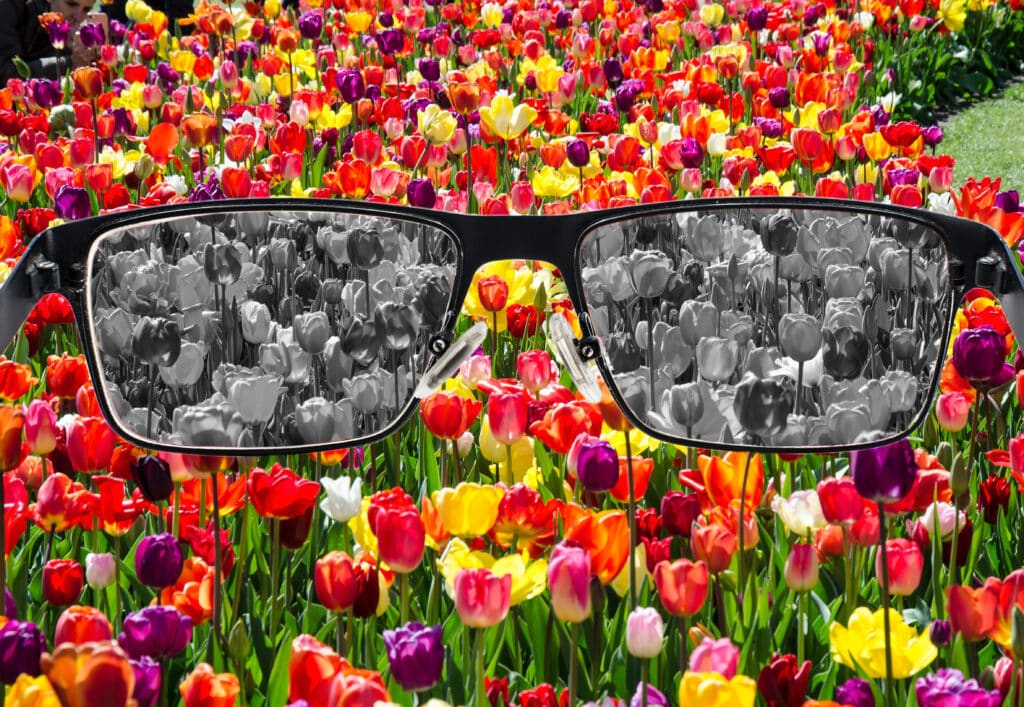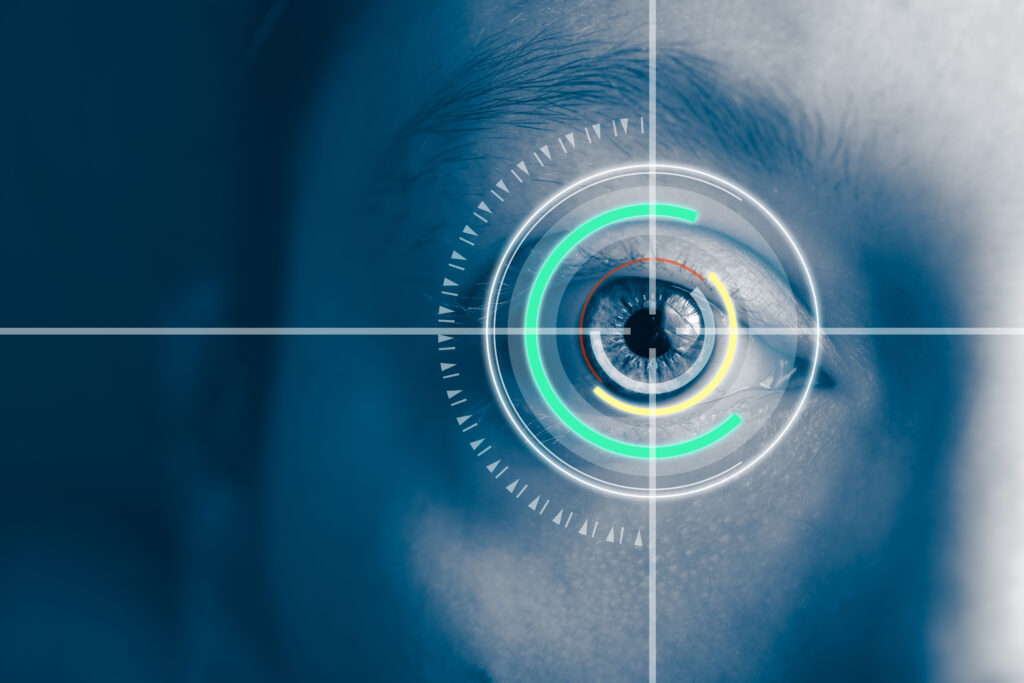Psychedelics cause hallucinations, sure; but can they also help you see? Is there a connection between psychedelics and eyesight?
Visions vs eyesight
It’s common knowledge that psychedelics (DMT, LSD, psilocybin, mescaline) cause hallucinations in users. These hallucinations can be related to any of the five senses: sight, taste, hearing, smell, tactile; and involve creating an experience that is not consistent with reality. This idea of seeing things differently, is emphasized by the bright, squiggly, trippy designs used to represent psychedelics and their accompanying trips.
Creating visions is quite different from regular eyesight. A vision, in this circumstance, is something not consistent with regular eyesight. It involves seeing things that aren’t there, or seeing them more or less clearly than when not on a drug. The colors might look brighter, objects might look distorted, and things like depth perception, might be off.
Eyesight is how your eyes see in general, sans drugs or devices; and can be affected by different eye disorders. Diminished eyesight is commonly seen in the form of near or farsightedness; as well as a result of other eye issues like glaucoma. All of these can impair how well a person actually sees, regardless of whether their brain is coming up with a bunch of hallucinations, or not.

If a person is on psychedelics and having visions that provide the ability to see more clearly, this ends at the end of the trip, right? Well, what if that isn’t true? What if psychedelics can have a lasting affect on eyesight? Some research indicates its possible that psychedelics can improve certain vision problems, over longer periods of time.
Research on psychedelics and eyesight – colorblindness
If LSD or magic mushrooms could immediately cure eye vision issues, we’d all know about it, and such a usefulness would likely make tripping, that much more of a common thing. Unfortunately, this isn’t the case. But just because they can’t immediately cure all seeing issues, doesn’t mean that they aren’t associated with benefits to vision.
A study was published in May, 2023, which investigated this issue, based on wider survey data taken a few years before. The survey data indicates color-blindness can improve long term, after using psychedelics. The study itself is on only one participant, though, so the provided data is very much limited. Even so, the case report shows how a subject with red-green colorblindness (aka deuteranomalia), reported an improvement in color-blindness after consuming magic mushrooms.
The subject ate five grams of dried magic mushrooms, and then self-administered the Ishihara Test (which assesses the degree of colorblindness). He found that he had peak improvement after eight days, and that improvements persisted for at least 16 days. It’s impossible to say if the effects lasted longer, as at this point, there were other substances used, which could skew results.
In terms of the survey results that spawned this investigation, they came from the Global Drug Survey (GDS) 2017, as can be seen in this investigation, called Improved colour blindness symptoms associated with recreational psychedelic use: Results from the Global Drug Survey 2017. GDS is an independent research firm based out of London, which provides the world’s largest online drug survey.
That year, a new question was added to the ‘psychedelics’ section, which specifically asked those who had used LSD or psilocybin in the last year, and who had colorblindness, if they saw any change in their vision. While this was only meant to collect information, there were enough clear and positive response, to create interest for researchers.

47 responses were able to be categorized, while 23 specifically mentioned an improvement. The length of time for improvement varied between respondents, from a number of days, to several years. Investigators posited that “Improved colour blindness may be a result of new photisms experienced in the psychedelic state aligning with pre-existing concepts of colour to be ascribed a label”. They go on, “Connections between visual and linguistic cortical areas may be enhanced due to disorder in the brain’s neural connections induced by psychedelics allowing these new photisms and concepts to become linked.”
Earlier research concluded it was the other way
This is not the first study into this topic. As it turns out, another, from 1982, included 46 subjects. In this study, called A chronic impairment of colour vision in users of LSD, investigators make the opposite point when it comes to color discrimination. The study used the 46 test participants, along with 31 controls. The measurement on color discrimination was made two years after LSD use, meaning there was a lot of space in between for confounding variables, including the use of other drugs.
The control participants scored better than the LSD users in color discrimination, two years after. Investigators also found that those from the LSD group with flashbacks, performed worse than those without flashbacks. Study authors concluded that “some users of LSD may have a sustained or irreversible impairment in colour discrimination.” Though there are a million holes to drive a truck through here, and while it gives a more negative answer than current thoughts indicate; it does bring up that psychedelics like LSD, can still have effects, long after use.
I’d be remiss not the mention that this study came out not long after drugs like LSD and magic mushrooms were made fully illegal; and very much in a time period when all public information on such drugs, was negative only. It stands to reason, considering the growing collection of positive research into these compounds and their effects today, that most likely anything to come out then, was in the vein of painting such drugs in a negative way. Just something to consider, as there was literally no positive research into LSD, coming out in 1982. Yet today, there’s nearly nothing negative.
DMT and glaucoma
So far, most of the limited research into this topic, is related to colorblindness. But there’s another story to pay attention to when it comes to psychedelics, and improving eyesight. This time its about DMT specifically, and a new analogue medicine made by the company Pharmadrug. Pharmadrug is a specialty pharmaceutical company that focuses on creating controlled substances and natural medicines.
In spring of 2022, the company announced that it had created, in conjunction with Terasaki Institute for Biomedical Innovation (TIBI), a novel device meant to deliver consistent amounts of its DMT-like drug, right to the eyes. The idea of this device and medication, is to lower the intraocular pressure associated with glaucoma, which is the main reason for glaucoma-related vision loss. The device is meant to keep levels consistent at all times.

Using DMT, along with the delivery device, comes from the ideas that DMT can reduce intraocular pressure; and that a consistent dosing instrument, can take away the issue of rising pressures during night time, or other times when a drug cannot be taken. The ability to do this is thought to be related to activation of 5HT-1a and 5HT-2a serotonin receptors. As all psychedelics are known to increase serotonin, this indicates other psychedelics have the property of improving eyesight in some cases, as well.
At the time of this announcement, the company was already in the planning stages for human trials, using an already accepted model of primary open glaucoma. The goal of the company is to file an application for a new investigative drug, and conduct trials to get official approval.
PharmaDrug CSO Paul Van Slyke had this to say about it: “We are excited to announce that our recently fabricated proprietary medical device, designed to deliver controlled release of tryptamine-based pharmaceutical agents, has now progressed from the concept stage into a functioning prototype.”
Conclusion
Psychedelics are gaining popularity for their ability to help with psychological issues, and are currently under research for a plethora of other benefits. It seems one of the many things psychedelics might be able to do, is improve certain problems related to eyesight, like colorblindness and glaucoma. And lets be honest, if they’re good for these things, they might have other benefits yet undiscovered, for eye health.
This is the second time that the eye disorder glaucoma has garnered positive attention for an illicit drug. Along with epilepsy and treatments for cancer and AIDS wasting, one of the primary uses of medical cannabis in the late 1900’s, was for glaucoma. This was subsequent to it being found in the 70’s that components of the plant bring down intraocular pressure. Since then there has been more research into cannabis for eye health.
Welcome everyone! Thanks for joining in at Cannadelics.com, an independent publication in the general wellness space, reporting on the most interesting stories out there. Don’t be a stranger, visit us frequently to stay current. And check out the Cannadelics Weekly Newsletter, for the best news and product promos, together in one place.









